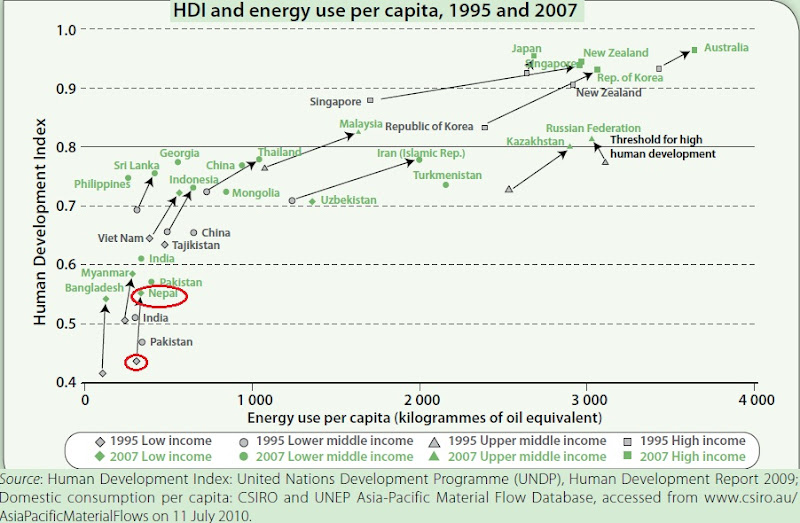 The information is derived from from a recent report on green growth in Asia and the Pacific. The domestic water use per capita (471 cubic meters per capita in 2000) in Nepal is below the estimated minimum requirement. Leakage, inadequate water quality, inefficient domestic water use, and underinvestment in providing access to basic services are common features in countries with low water use per capita. No surprise that people in major urban centers can run their taps just for few hours each week. The work to channel water supply from Melamchi is yet to be realized ever after so many years of commencement of its construction.
The information is derived from from a recent report on green growth in Asia and the Pacific. The domestic water use per capita (471 cubic meters per capita in 2000) in Nepal is below the estimated minimum requirement. Leakage, inadequate water quality, inefficient domestic water use, and underinvestment in providing access to basic services are common features in countries with low water use per capita. No surprise that people in major urban centers can run their taps just for few hours each week. The work to channel water supply from Melamchi is yet to be realized ever after so many years of commencement of its construction.
Domestic material (including energy) consumption is pretty low (fifth lowest—2.64 tons per capita in 2005) compared to other countries in the continent. It signals potential for future growth by exploiting the available materials for consumption and production. Furthermore, per capita energy use is the third lowest (14.36 gigajoules per capita), followed by Myanmar and Bangladesh, in Asia and the Pacific. Note that countries with high energy use per capita tend to have high HDI value.

Recommendations for green growth and resource sustainability:
- Infrastructure investments should be guided by the principles of sustainability, accessibility, and social inclusiveness.
- “Natural infrastructure” provides valuable but undervalued economic inputs. Natural capital investments will help to secure critical ecosystem services (such as water regulation and flood control), achieve cost savings on infrastructure development, improve human and environmental security and can strengthen climate adaptation efforts through ecosystem-based adaptation approaches. Sustainable management of natural capital also enhances the potential for ecosystem services for economic transformation—for example where eco-tourism potential is developed as an economic development strategy. Investments should be targeted at key ecosystem services that hold particular value for their economies and societies.
- Sustainable agriculture is a critical aspect of maintaining and building natural capital.
- Greening of growth requires integrated strategies that support systemic change in integrated, complementary and mutually reinforcing ways. The complexity of challenges faced means that a clear vision, targets and monitoring approach are required. Also needed are targets and indicators that give policy-relevant information on the extent to which the economy is “growing green.”
- To ensure greater resilience, domestic policies should also encourage diversification in key sectors, such as industry, agriculture and energy.
- Approaches that enhance the capacity of communities and economies to resist initial shocks and to self-organize and adapt to changing conditions will be increasingly important.
- A transition to a green economy requires governance that is effective, fair and
inclusive.